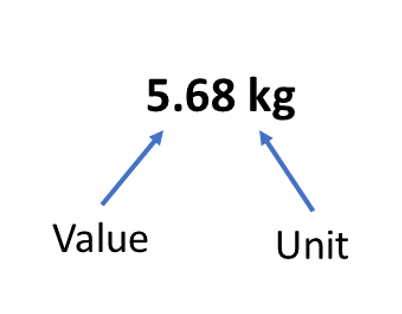Units and conversions
If you expressed a quantity without a unit, it would not provide much information. For instance, you say to a friend that you have gained \(3kg\) during the past three months. If you say just three without kilograms, it won’t make sense to your friend as three can be in any units we use to measure mass, such as grams, miligrams, kilograms, pounds etc. Therefore, adding a unit next to a quantity is essential to get the correct information.

A physical quantity can be measured in several units. For instance, weight can be expressed in kilograms, grams, pounds etc. Therefore, scientists have introduced standard units for each physical quantity to avoid confusion. This system is known as the international system of units (SI Units).
Some SI units and symbols
| Quantity | Unit | Symbol |
|---|---|---|
| Mass | Kilogram | \(kg\) |
| Length | Metre | \(m\) |
| Volume | Cubic metre | \(m^{3}\) |
| Temperature | Kelvin | \(K\) |
| Time | Second | \(s\) |
| Electric current | Ampere | \(A\) |
| Amount of substance | Mole | \(mol\) |
| Luminous intensity | Candela | \(cd\) |
A common issue associated with any measuring system is that depending on the quantity, the unit we use might be inconvenient to express. For instance, expressing the diameter of a bacterial cell \(\left(0.0000001m\right)\) in metres is challenging. Therefore, prefixes have been introduced to express such measurements. The multiples and fractions of SI units are expressed with prefixes.
Common SI and matrix unit prefixes
| Prefix | Symbol | Multiplied by |
|---|---|---|
| giga | G | \(10^{9}\) |
| mega | M | \(10^{6}\) |
| kilo | \(k\) | \(10^{3}\) |
| deci | \(d\) | \(10^{-1}\) |
| centi | \(c\) | \(10^{-2}\) |
| milli | \(m\) | \(10^{-3}\) |
| micro | \(\mu\) | \(10^{-6}\) |
| nano | \(n\) | \(10^{-9}\) |
| pico | \(p\) | \(10^{-12}\) |
Unit Conversions
We can use conversion factors to convert one unit to another. For instance, conversion of miligrams to grams. From prefixes we know \[ 1000mg=1g \]
Both \(1000mg\) and \(1g\) refer to the same amount, but in different units. Based on this relationship we can create pair of conversion factors \[ \frac{1000mg}{1g}\:\:\textrm{and}\:\:\frac{1g}{1000mg} \]
Express \(150.0mg\) in grams? We can calculate \(150mg\) in grams using the conversion factor \(\frac{1g}{1000mg}\) as follows \[ \frac{1g}{1000mg}\times150.0mg=0.1500g \]
Express \(0.275g\) in milligrams? Here we can use the other conversion factor \(\frac{1000mg}{1g}\) as follows \[ \frac{1000mg}{1g}\times0.275g=275mg \]
When you observe these two calculations, you can identify that the conversion factor used from the pair depends on the unit required to be converted.
Other Conversions
Time
To change from hours to seconds we multiply by 3600 since there are (60 x 60) seconds in 1 hour. Conversely, we divide by 3600 to change from seconds to hours.
Multiple conversions
Velocity may be given in km/h. To change to m/s involves two conversions:
1 km/h = 1000 m/h = (1000/3600) m/s = (1/3.6) ms
Examples
60 km/h = (60/3.6) = 16.7 m/s. To change from km/h to m/s divide by 3.6
20 m/s = 20 x 3.6 = 72 km/h. To change from m/s to km/h multiply by 3.6
What's next... Exercise - units and conversions
